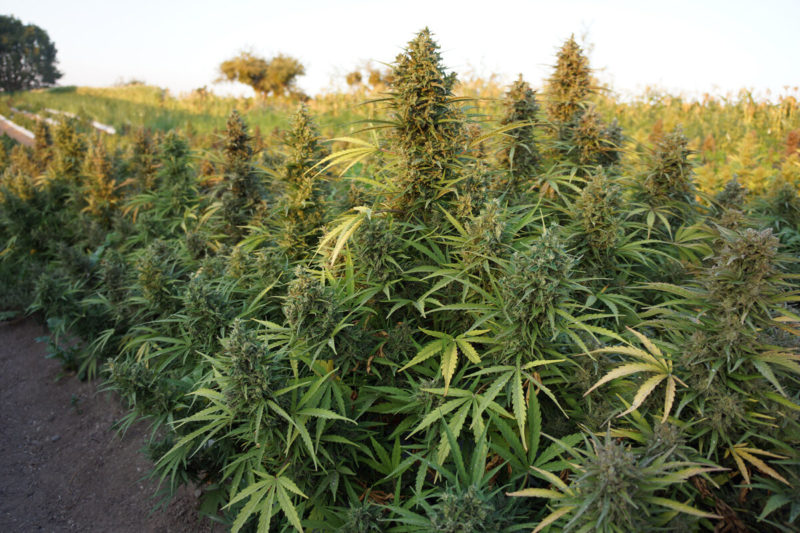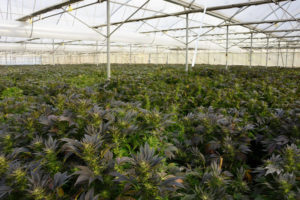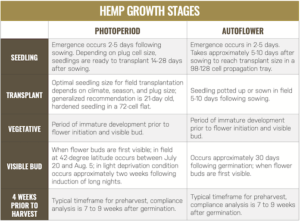
Photoperiod Versus Autoflower Hemp
Just as in ornamental production, hemp growers have short day and day-neutral options. The best fit for a grower will depend on geographic location, production and equipment capabilities, and end use, among other factors.
California-based Beacon Hemp began growing and selling its own hemp under the 2014 Farm Bill, and then switched to breeding and selling its own genetics after an increasing demand from the industry.
“Essentially Beacon began because we had a lot of our extractors that we worked with constantly asking for clones or seeds, or for us to grow for them at a scale that was beyond what we could handle,” says Nick Stromberg, founder and CEO of Beacon Hemp. “They were seeing that our genetics outperformed the other options on the market.”
Stromberg has a bachelor’s degree in environmental horticulture and a master’s degree in horticulture and agronomy from the University of California, Davis. He also spent time working at a cannabis analytical lab under Dr. Don Land, a leading analytical chemist in cannabis.
“There was also a deficit of the amount of CBD available for the demand that was there,” says Stromberg. “That’s when I really dove headfirst into growing more of it, and alongside of that, making selections in breeding. The varieties that were available at the time were really left something to be desired.”
Beacon Hemp currently offers 17 varieties of photoperiodic and day neutral hemp.
Photoperiod (Short-Day)
Photoperiod hemp flower generally has a higher cannabinoid content and has an aesthetic like that of manicured marijuana — which gets more traction in the smokable market.

“People want the product to look very nice and often have an aroma or appearance that is analogous to a specific variety of psychoactive cannabis, but they want the version that isn’t going to be psychoactive… They want to have that CBD version of ‘OG Kush’ or CBD version of ‘Sour Diesel’.”
Most greenhouse growers use photoperiodic varieties, which will grow vegetatively provided that the number of hours of uninterrupted darkness are below the critical threshold to initiate flowering. However, the necessary hours of darkness can vary by variety.
“[Typically] it’s around 10.5 or 11 hours, if you’re talking about natural season (no light manipulation),” says Stromberg. “The beginning of flowering will usually occur around the end of July or beginning/middle of August, depending on your latitude. If you’re artificially controlling the number of hours of light and darkness in a controlled atmosphere, like a greenhouse or indoors, typically people are giving it 12 hours of light and 12 hours of darkness when they want to initiate flowering.”
In greenhouse production, 2- to 5-gallon containers are commonly used. Stromberg notes 1-gallon containers can be used but “it’s just trickier when you have so much less substrate for plants that typically get fairly large.” Spacing is usually between 2 1⁄4 square feet to 6 square feet per plant; however, this will depend on container size, variety and cultural practices.
Beacon Hemp offers two lines of high CBD, photoperiodic hemp: Early Line and Quik Line. Two of its top selling cultivars are ‘Early Cherry’ and ‘Early Wu’. Both have dense, round flowers and a CBD:THC ratio ranging from 24:1 to 32:1.
Autoflower (Day Neutral)
Growers looking to harvest prior to fall or to extend their season can use autoflower hemp varieties, says Stromberg. This type of hemp will begin to flower approximately 30 days after germination, regardless of the number of hours of darkness per day. These varieties can be used for smokable end products, but they are more popularly used in the pre-roll and biomass markets.

Autoflower hemp grows smaller (approximately 2.5-4 feet in height and 2-3 feet in diameter), making mechanical harvesting easier. Beacon Hemp recommends planting autoflower varieties at higher densities (1-2 square feet per plant in 1-2 gallon containers) than photoperiodic varieties. Beacon Hemp’s varieties typically begin to flower 30 days after germination and are ready to harvest in 75 to 90 days.
Unlike their photoperiod counterparts, autoflower varieties cannot be propagated in loose-fill media. Preformed media is best for the plant’s minimal root growth to hold soil better during transplant. Beacon Hemp recommends using polymer plugs over stonewool. In addition, autoflower hemp requires more nitrogen than photoperiod. A short vegetative stage means supplying plants with nitrogen fertilizer early.
Beacon Hemp’s line of high CBD, autoflower hemp features six cultivars. ‘Auto Tune’ — featuring dense flowers that form long terminal colas — and ‘Auto Blunami’ — with expansive terminal flowers on all branches — are the most popular.
Stromberg cautions growers on producing more than they know what to do with. “Growing it is the easy part,” he says. “It’s everything after that is more difficult.”
Planning for harvest and postharvest prior to getting into production will prevent problems down the road. Staggering harvest dates, especially with autoflower varieties, will prevent worrying about your crop getting hot if you can’t harvest it all in time.
“The big mistake that we saw happen in 2019, and to some degree we’re still seeing it echo now, is that a lot of people thought that they were going to make fortunes in one season,” Stromberg says. “That overproduction hurt the entire industry — including the people that executed well and are riding through the storm. It affected their bottom line, because to be competitive, the prices had to crater. You essentially had to compete with people that were selling just to get as close to whole as they possibly could. I’d recommend greenhouse growers be very diligent. Don’t get into it too big too fast.”

While Beacon Hemp does not provide agronomic support for growers, Stromberg says they can direct growers to professionals in the industry that can help with their specific needs. Cultivation guides are available on the company’s website (www.beaconhemp.com/hemp-cultivation-techniques) for each of its varieties. A hemp catalog on the website also includes information on how to select a variety and how to estimate your seed needs by determining your planting density.
Breeding efforts at Beacon Hemp are now focusing on new minor cannabinoids, such as CBG, CBG-V and CBD-V. Day neutral versions are in the works first with photoperiod versions to follow. The “beauty” of these cannabinoids is the consistent production of postharvest compliant flower, Stromberg says.
“The way the testing is done for compliance purposes is everything is sampled preharvest,” Stromberg says. “A lot of the cannabinoid development occurs in the last month of that reproductive growth. So, something that tests at .2% Delta-9 THC at the time of sampling will technically be legal; however, it very likely is going to be at or above half a percent THC postharvest. While this is currently not a huge issue, we see it as potentially being an issue in the future and having seed offerings that produce flowers that is always compliant has been a top priority for us.”
Beacon Hemp is also working on earning AOSCA certification for all its varieties. ‘Auto Blues’ and ‘Auto Blunami’ are currently certified.



